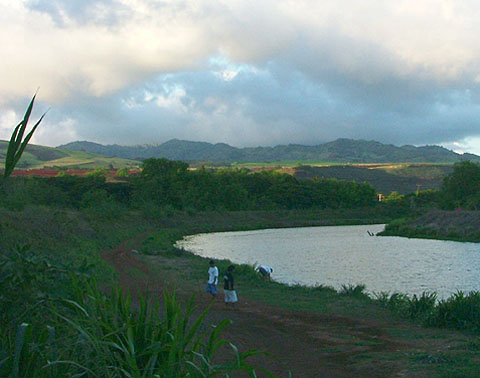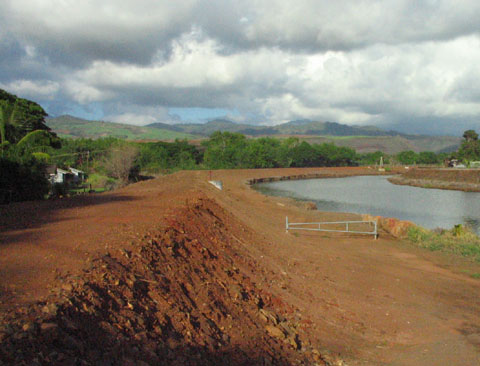by Juan Wilson on 7 November 2007
Yesterday I spoke with Linda Harmon, who wrote a previous article on the Hanapepe Levee situation. She said she had recently talked to the Kauai Engineerng Departent and had been told they were considering a temporary spray-on polymer coating to get the levees through the winter rains. Without some protection there is a good possibility of severe erosion to the levees that were built back up early in the summer.
I called the Engineering Department today to speak to them of my own concerns. I documented them in a email that I reproduce below.
Donald Fujimoto (dfujimoto@kauai.gov)
Engineering Department
Kauai County
cc: Ryan Nishikawa (rnishikawa@kauai.gov)
Project Manager
Thank you for your time today in listening to my concerns regarding the possible polymer spraying of the Hanapepe Levee embankments to stabilize them through the winter rains. It is a shame that this needs to be considered. The levees have been bare of even a blade of grass for months now and a timely planting of the proper species would have obviated this need. I have been told that the lack of irrigation water was the reason for the delay. It would have been
wise for the Army Corps of Engineers to anticipate such a requirement and budget it.
Now we face the rains of winter. I understand you have considered two approaches that might work now.
Solution One: To blow on a commercial mix of seed, nutrient and stabilizer as used on highway embankments. The runoff from that would need to be evaluated. In the case of the west levee the embankment leads to a fresh and brackish water river on one side and farmland on the other. In the case of the east levee the earth embankment faces dense and close by residential housing. This has been determined to be too expensive.
Solution Two: To spray a polymer plastic on the embankment that would form a "crust" over the earth that would resist gullying from hard rain. This, as I understand it, would be biodegradable and would be replaced at a later time by a permanent landscaping solution, when there would be a budget available for such an installation. The initial spraying would be within the current budget.
I have three reservations that I spoke to you on the phone about today about Solution Two.
1) I was concerned that the polymer would be in a catalytic state when applied. This would mean a possibly dangerous chemistry that would be airborne. You confirmed that indeed, the polymer would be in a catalytic state. This usually means chemical face masks are required during application. I suspect this could be at least as dangerous as the application of pesticides. If spraying occurs that requires applicators to wear masks (particularly chemical masks) I
suggest that nearby residents be notified and be out of the area while the catalytic spray is in the air and until it is "set". The last major spraying of pesticide on the west embankment was done early in the morning without notification. I know of two women (one elderly and one pregnant) who woke up feeling nauseated. The younger woman had a miscarriage within days.
2) The fact that the polymer is biodegradable does not make it safe. When it breaks down it may do what some other plastics in rivers do when they break down... mimic organic chemistry. Estrogen mimickers are thought too be an agent in fish and amphibian die-offs in some watersheds. If not organic chemistry, other by products of the degradation of the polymer could affect the nearby farming and certainly the life in the river (crabs and fish are frequently gathered
in this area). We need to know the byproduct breakdown of this polymer in sunlight and brackish water.
3) Runoff of the polymer chemistry into the ocean could be another significant threat. There are spawning and breeding grounds of commercial fish at the mouth of the Hanapepe River. It is so rich that fishing boats are drawn to the area and illegally set up nets to harvest inside the bay. What effect will this large polymer application on the levees have at the mouth of the river? Or for that matter, beyond on the reefs and coastline of Puolo Point and Salt Pond
Beach Park? Do the polymer byproducts float on saltwater? Could the many people who swim at the county park be affected? I don't want to find out.
In my judgment a safer, even if more expensive, approach should be taken. We saw at Waimea Canyon Middle School that even when the manufacturer (Sygenta) of the spray on product (Touchdown) followed their own protocol, things still can go wrong. Will the county, as an inexperienced third party, do better with a technology untested on Kauai?
The Precautionary Principle should apply in Hanapepe Valley. It is a densely populated area with sensitive environmental elements on all sides.
If the County can spend over a million dollars to sue itself, can't we afford to have a safe embankment?
|

image above: In 2004 - looking east towards the Hanapepe Swinging Bridge at vegetated levee.
Photo by Juan Wilson
|

